Jan Josef Horemans the Elder (1682–1759) stands as a significant figure in 18th-century Flemish art. Based in Antwerp, he dedicated his career primarily to genre painting, capturing the multifaceted aspects of everyday life during his time. His works serve as valuable visual documents, offering intimate glimpses into the homes, workplaces, and social gatherings of ordinary Flemings. Horemans developed a distinctive style characterized by careful observation, lively detail, and often a gentle humour, continuing the rich tradition of genre painting established by earlier Flemish masters while adapting it to the tastes and sensibilities of the 18th century. His prolific output and the enduring appeal of his subjects have secured his place as a key chronicler of Antwerp society.
Early Life and Artistic Formation
Born in the bustling port city of Antwerp in 1682, Jan Josef Horemans entered a world where the artistic glories of the previous century, dominated by figures like Peter Paul Rubens and Anthony van Dyck, still cast a long shadow, yet contemporary artists were forging new paths. Information regarding his earliest training is somewhat sparse, but it is believed he may have initially studied under the sculptor Michiel van der Voort the Elder. This potential grounding in three-dimensional form might have subtly influenced his later approach to figure composition in his paintings.
A more definitive step in his artistic journey occurred around 1694-95 when he became apprenticed to the painter Jan van Pee. Van Pee, though perhaps not as renowned today, would have provided Horemans with practical training in the techniques of oil painting, composition, and the preparation of materials, essential skills for any aspiring artist. This period of apprenticeship was crucial for honing his craft and absorbing the prevailing artistic conventions of the Antwerp school.
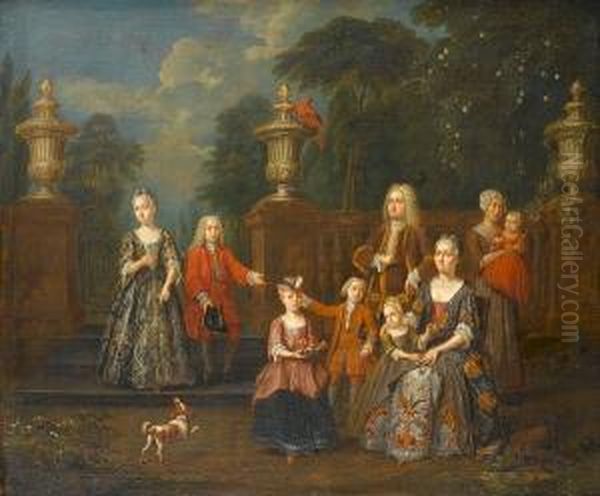
Horemans's dedication and talent were formally recognized in 1706 when he was admitted as a master painter into the prestigious Guild of Saint Luke in Antwerp. Membership in the Guild was a prerequisite for practicing professionally as an independent artist, allowing him to establish his own workshop, take on apprentices, and sell his works freely. This marked the official commencement of a long and productive career centered in his native city.
Artistic Style and Influences
Jan Josef Horemans the Elder developed a style deeply rooted in the Flemish genre tradition, particularly echoing the work of 17th-century masters like David Teniers the Younger and Adriaen Brouwer. Like Teniers, Horemans excelled at depicting scenes of peasant life, tavern interiors, and domestic activities, but he often imbued his scenes with a slightly more refined, less boisterous atmosphere suited to the changing tastes of the 18th century. His connection to this lineage is evident in his attention to detail, his skillful rendering of textures, and his ability to capture expressive figures in everyday situations.
His brushwork is typically fine and controlled, allowing for meticulous depiction of clothing, furniture, and the various objects that populate his scenes. This detailed approach lends an air of authenticity and immediacy to his work. While capable of capturing moments of lively activity, Horemans's paintings often possess a certain calmness and order. The compositions are generally clear and well-structured, guiding the viewer's eye through the narrative elements within the scene.
A notable characteristic of Horemans's style, sometimes referred to using the term "bruno," involves his adept use of chiaroscuro – the contrast between light and shadow. He frequently employed darker, subdued backgrounds or interiors, allowing pools of light to illuminate the main figures and focal points of the composition. This technique not only adds a sense of depth and volume but also creates a subtle dramatic effect, drawing attention to the interactions and activities being portrayed. His palette often favoured warm earth tones, contributing to the intimate and accessible atmosphere of his paintings.
Themes of Everyday Life
The core of Horemans's oeuvre lies in his fascination with the daily lives of his contemporaries. He cast his observational net wide, capturing a diverse range of activities and social settings. His works provide a rich tapestry of 18th-century Antwerp life, moving from the private sphere of the home to the more public arenas of work and leisure.
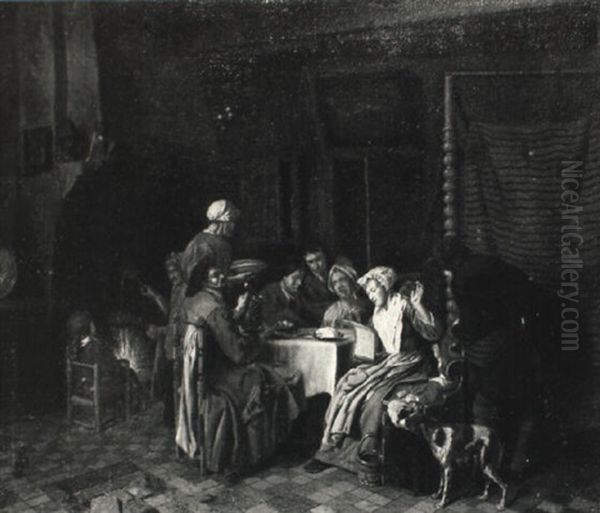
Domestic interiors feature prominently. He painted numerous scenes of families gathered together, engaged in simple activities like meals, conversation, or childcare. These works often convey a sense of warmth and intimacy, reflecting the importance of family life. Examples like Family Portrait showcase his ability to combine portraiture with genre elements, depicting specific individuals within a characteristic domestic setting.
Social gatherings were another favourite theme. Horemans depicted elegant companies enjoying music parties, playing cards, or partaking in the fashionable ritual of tea drinking. Works such as Tea Party and Elegant Company Scene capture the manners and attire of the more affluent segments of society, offering glimpses into their leisure activities and social interactions. These scenes often possess a lighthearted, convivial atmosphere.
Work, Profession, and Leisure
Beyond the home and polite society, Horemans turned his attention to the world of work and professional life. He depicted artisans in their workshops, merchants conducting business, and even professionals like doctors and dentists attending to their patients. His paintings of medical procedures, such as The Surgeon Attending a Patient or the popular subject The Tooth Puller, are particularly noteworthy. These works are rendered with a matter-of-fact realism, documenting practices that were a common, if sometimes uncomfortable, part of 18th-century existence. They reflect his keen eye for detail and his interest in diverse aspects of human experience.
Leisure activities, both indoors and outdoors, also captured his imagination. Tavern scenes, while perhaps less rowdy than those of Brouwer or Teniers, depict people drinking, smoking, and socializing. He also painted outdoor scenes, including elegant figures strolling in park-like landscapes, as seen in Elegant Family Group in a Park Landscape. These works often combine landscape elements with genre figures, showcasing a broader range of settings.
Furthermore, Horemans explored allegorical themes, notably through series depicting the Four Seasons. These works typically combined landscape or interior settings appropriate to the season (e.g., harvesting for Summer, indoor warmth for Winter) with figures engaged in corresponding activities, blending genre realism with traditional symbolism.
Notable Works
Several paintings stand out as representative examples of Jan Josef Horemans the Elder's style and thematic concerns:
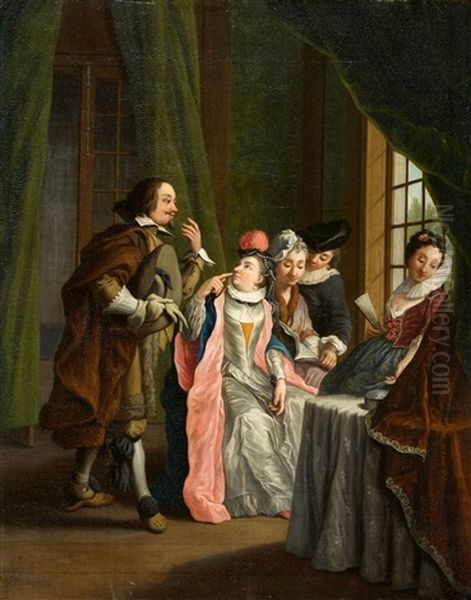
The Surgeon Attending a Patient: This work exemplifies Horemans's interest in professional life and his detailed, observational approach. The scene typically depicts a surgeon, often in a domestic setting rather than a formal clinic, performing a procedure like bloodletting or treating a wound. The focus is on the action and the reactions of the figures involved, rendered with clarity and a degree of detachment.
Tea Party: Reflecting the growing popularity of tea in 18th-century Europe, this subject appears multiple times in Horemans's work. These paintings usually show a group of well-dressed men and women gathered around a table set with porcelain cups and a teapot. The emphasis is on the social ritual, the elegant attire, and the polite interactions, capturing a moment of refined leisure.
Elegant Company Scene / Music Party: Similar to the tea parties, these scenes depict affluent individuals enjoying music, conversation, or games in well-appointed interiors or garden settings. They highlight Horemans's ability to portray group dynamics and create a sense of sophisticated sociability, often featuring detailed renderings of musical instruments, furniture, and fashionable clothing.
The Tooth Puller: A recurring theme in genre painting, Horemans's versions depict the itinerant tooth puller, often at a market or fair, extracting a tooth from a suffering patient, usually surrounded by curious onlookers. These scenes blend elements of everyday hardship, medical practice (however crude), and sometimes a touch of theatricality or dark humour.
Family Portrait / Domestic Interior: Numerous works fall into this category, showcasing families in their homes. These paintings emphasize domestic harmony and routine, providing valuable insights into interior decoration, clothing, and family structures of the period.
These examples illustrate the core elements of Horemans's art: detailed realism, a focus on human activity and interaction, clear narrative, and an ability to capture the specific atmosphere of different social settings.
The Horemans Family and Workshop
Artistic practice often ran in families, and the Horemans were no exception. Jan Josef the Elder's younger brother, Peter Jacob Horemans (1700–1776), also became a painter. Peter Jacob initially trained with his older brother before moving to Munich around 1725. There, he enjoyed considerable success, becoming court painter to Charles VII Albert, Elector of Bavaria (and briefly Holy Roman Emperor). Peter Jacob specialized in portraits and genre scenes, often depicting courtly life, and his style, while related to his brother's, adapted to the tastes of the Bavarian court.
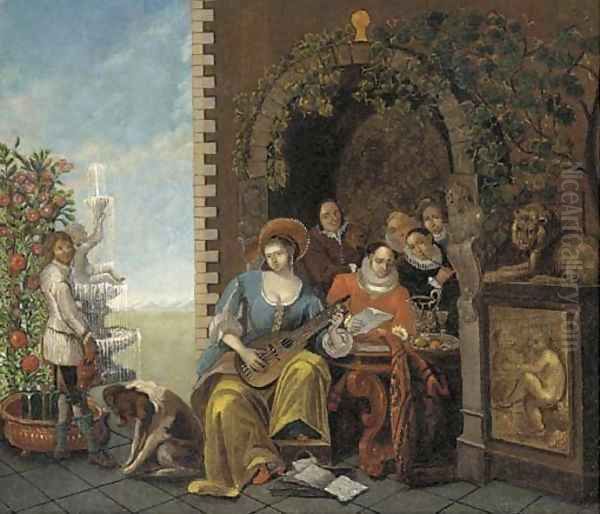
Jan Josef Horemans the Elder also passed on his artistic legacy to his son, Jan Josef Horemans the Younger (1714–after 1790). The Younger closely followed his father's style and subject matter, making it sometimes difficult to distinguish between their works, especially since he often signed his paintings similarly. He continued the tradition of painting Antwerp genre scenes, interiors, and conversation pieces. It was Jan Josef the Younger, not the Elder, who served as Dean of the Guild of Saint Luke in Antwerp in 1768-69 and again in 1775-76, indicating his own standing within the local artistic community long after his father's death.
Jan Josef the Elder also took on other pupils besides his family members. One documented student was Johan Herman Faber, who trained with him before pursuing his own career. The Horemans workshop, led first by the Elder and likely continued in spirit by the Younger, played a role in perpetuating the specific style of Antwerp genre painting into the later 18th century.
Contemporaries and the Antwerp Artistic Milieu
Jan Josef Horemans the Elder worked during a period when Antwerp, while no longer the dominant artistic powerhouse it had been in the 17th century, still maintained a vibrant local art scene centered around the Guild of Saint Luke. He was contemporary with several other Flemish artists who contributed to the diverse artistic landscape of the time.
In Antwerp itself, painters like Balthasar van den Bossche (1681–1715) also specialized in elegant genre scenes and depictions of artists' studios, sharing some thematic ground with Horemans. Members of the Bredael family, such as Peter van Bredael (1629–1719, though older) and Alexander van Bredael (1663–1720), were known for market scenes and landscapes with figures, contributing to the broader genre tradition. While direct collaborations are not heavily documented, Horemans would certainly have been aware of and interacted with these local colleagues within the Guild framework. Figures like Jan van den Broeck were also members of the same Guild.
Looking slightly beyond Antwerp but within the Flemish context, the landscape painter Jean Demarne (1752-1829, though mostly later) represents the continuation of Flemish traditions. Flower painters like Gaspar Peeter Verbruggen the Younger (1664–1730) and Jacob van Huysum (c. 1687/89 – 1740), who worked in Antwerp and later Amsterdam and England, represented another strong Flemish specialty.
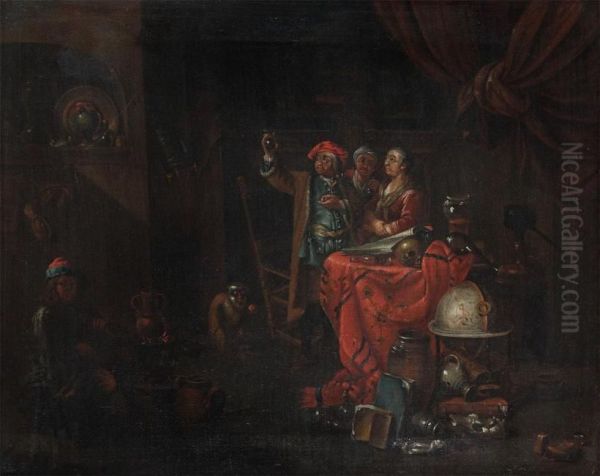
In the broader context of the Low Countries and Europe, Horemans's career overlapped with prominent figures in the Dutch Republic, such as the Leiden 'fijnschilders' like Willem van Mieris (1662–1747), known for their highly detailed genre scenes, and the celebrated flower painter Rachel Ruysch (1664–1750). Though stylistically different, the classicist Adriaen van der Werff (1659–1722) was another major Dutch contemporary. In France, the Rococo style was flourishing with Antoine Watteau (1684–1721), whose fêtes galantes depicted idealized elegant gatherings, and Jean-Baptiste Oudry (1686–1755), known for animal paintings and still lifes. While Horemans's style remained distinctly Flemish and less overtly decorative than French Rococo, the shared interest in depicting social life reflects broader European artistic trends of the 18th century.
Legacy and Influence
Jan Josef Horemans the Elder's primary legacy lies in his dedicated and skillful continuation of the Flemish genre painting tradition into the 18th century. At a time when artistic tastes were shifting, he successfully adapted the detailed realism and narrative focus of earlier masters to contemporary subjects and sensibilities. His extensive body of work provides an invaluable visual record of Antwerp life, documenting the customs, clothing, interiors, and activities of various social strata.
His influence was most directly felt through his family and pupils. His son, Jan Josef the Younger, ensured the continuation of the Horemans style for several more decades. His brother, Peter Jacob, carried a related Flemish genre style to the court in Munich. Through students like Johan Herman Faber, his methods were disseminated further.
More broadly, Horemans's work contributed to the enduring popularity of genre painting. His paintings, often modest in scale and depicting accessible, relatable scenes, found a ready market among the middle and upper classes. The clarity, detail, and often gentle humour of his works made them appealing decorative items for domestic interiors. This market success likely encouraged other artists to pursue similar themes.
While perhaps not an innovator on the scale of the great 17th-century masters, Horemans the Elder played a crucial role as a preserver and adapter of a significant artistic tradition. His keen observational skills, combined with his fine technique and prolific output, make him a key figure in 18th-century Flemish art. His paintings continue to be appreciated not only for their artistic merit but also for the rich historical insights they offer into the everyday world of centuries past.
Conclusion

Jan Josef Horemans the Elder was a master chronicler of his time. Through hundreds of paintings produced over a long career, he captured the essence of 18th-century Antwerp life with remarkable detail and empathy. From intimate family moments and elegant social gatherings to scenes of labour and medical practice, his work encompasses a wide spectrum of human experience. Influenced by the great Flemish genre painters before him, he developed a distinctive and popular style characterized by fine execution, clear storytelling, and skillful use of light. His legacy endures not only through his own paintings but also through the work of his brother, son, and pupils, solidifying his position as a significant and engaging figure in the history of Flemish art. His canvases remain windows into a bygone era, rendered with a clarity and charm that continue to resonate with viewers today.